Tupolev Tu-154
The Tupolev Tu-154 (Russian: Tyполев Ту-154; NATO reporting name: "Careless") is a three-engine medium-range narrow-body airliner designed in the mid-1960s and manufactured by Tupolev. A workhorse of Soviet and (subsequently) Russian airlines for several decades, it carried half of all passengers flown by Aeroflot and its subsidiaries (137.5 million/year or 243.8 billion passenger km in 1990), remaining the standard domestic-route airliner of Russia and former Soviet states until the mid-2000s. It was exported to 17 non-Russian airlines and used as a head-of-state transport by the air forces of several countries.
| Tu-154 | |
|---|---|
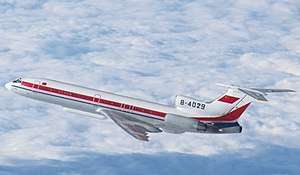 | |
| The Tu-154 is a low-wing, trijet airliner | |
| Role | Narrow-body jet airliner |
| National origin | Soviet Union and Russian Federation |
| Manufacturer | Tupolev |
| Designer | Tupolev Design Bureau |
| First flight | 4 October 1968 |
| Introduction | 7 February 1972 with Aeroflot |
| Status | In limited service |
| Primary users | Russian Air Force People's Liberation Army Air Force Air Koryo ALROSA Airlines |
| Produced | 1968–2013[1] |
| Number built | 1,026 |
| Variants | Tupolev Tu-155 |
With a cruising speed of 850 kilometres per hour (530 mph)[2] the Tu-154 is one of the fastest civilian aircraft in use and has a range of 5,280 kilometres (3,280 mi). Capable of operating from unpaved and gravel airfields with only basic facilities, it was widely used in the extreme Arctic conditions of Russia's northern/eastern regions where other airliners were unable to operate. Originally designed for a 45,000-hour service life (18,000 cycles) but capable of 80,000 hours with upgrades, it was expected to continue in service until 2016, although noise regulations have restricted flights to western Europe and other regions.
Since 1968 there have been 39 fatal incidents involving the Tu-154, most of which were caused either by factors unrelated to the aircraft, incorrect maintenance, or by its extensive use in demanding conditions. Few of the Tu-154 accidents appear to have involved technical failure.[3][4]
Development

The Tu-154 was developed to meet Aeroflot's requirement to replace the jet-powered Tu-104 and the Antonov An-10 and Ilyushin Il-18 turboprops. The requirements called for either a payload capacity of 16–18 tonnes (35,000–40,000 lb) with a range of 2,850–4,000 kilometres (1,770–2,490 mi) while cruising at 900 km/h (560 mph), or a payload of 5.8 tonnes (13,000 lb) with a range of 5,800–7,000 kilometres (3,600–4,300 mi) while cruising at 850 km/h (530 mph). A takeoff distance of 2,600 metres (8,500 ft) at maximum takeoff weight was also stipulated as a requirement. Conceptually similar to the British Hawker Siddeley Trident, which first flew in 1962, and the American Boeing 727, which first flew in 1963, the medium-range Tu-154 was marketed by Tupolev at the same time as Ilyushin was marketing the long-range Ilyushin Il-62. The Soviet Ministry of Aircraft Industry chose the Tu-154 as it incorporated the latest in Soviet aircraft design and best met Aeroflot's anticipated requirements for the 1970s and 1980s.[5]
The first project chief was Sergey Yeger; in 1964, Dmitryi S. Markov assumed that position. In 1975, the project lead role was turned over to Aleksandr S. Shengardt.[6]
The Tu-154 first flew on 4 October 1968. The first deliveries to Aeroflot were in 1970 with freight (mail) services beginning in May 1971 and passenger services in February 1972. There was still limited production of the 154M model as of January 2009 despite previous announcements of the end of production in 2006.[7] 1025 Tu-154s have been built, 214 of which were still in service as of 14 December 2009.[8] The last serial Tu-154 was delivered to the Russian Defense Ministry on 19 February 2013[9] from the Aviakor factory, equipped with upgraded avionics, a VIP interior and a communications suite. The factory has four unfinished hulls in its inventory which can be completed if new orders are received.[10]
Design
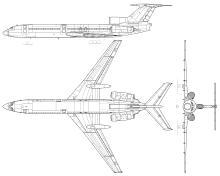
The Tu-154 is powered by three rear-mounted low-bypass turbofan engines arranged similarly to those of the Boeing 727, but it is slightly larger than its American counterpart. Both the 727 and the Tu-154 use an S-duct for the middle (Number 2) engine. The original model was equipped with Kuznetsov NK-8-2 engines, which were replaced with Soloviev D-30KU-154 in the Tu-154M. All Tu-154 aircraft models have a relatively high thrust-to-weight-ratio which give excellent performance, at the expense of lower fuel efficiency. This became an important factor in later decades as fuel costs grew.
The cockpit is fitted with conventional dual yoke control columns. Flight control surfaces are hydraulically operated.
The cabin of the Tu-154, although of the same six-abreast seating layout, gives the impression of an oval interior, with a lower ceiling than is common on Boeing and Airbus airliners. The passenger cabin accommodates 128 passengers in a two-class layout and 164 passengers in single-class layout, and up to 180 passengers in high-density layout. The layout can be modified to what is called a winter version where some seats are taken out and a wardrobe is installed for passenger coats. The passenger doors are smaller than on its Boeing and Airbus counterparts. Luggage space in the overhead compartments is very limited.
Like the Tupolev Tu-134, the Tu-154 has a wing swept back at 35° at the quarter-chord line. The British Hawker Siddeley Trident has the same sweepback angle, while the Boeing 727 has a slightly smaller sweepback angle of 32°. The wing also has anhedral (downward sweep) which is a distinguishing feature of Russian low-wing airliners designed during this era. Most Western low-wing airliners such as the contemporary Boeing 727 have dihedral (upward sweep). The anhedral means that Russian airliners have poor lateral stability compared to their Western counterparts, but also are more resistant to Dutch roll tendencies.
Considerably heavier than its predecessor Soviet-built airliner the Ilyushin Il-18, the Tu-154 was equipped with an oversized landing gear to reduce ground load, enabling it to operate from the same runways. The aircraft has two six-wheel main bogies fitted with large low-pressure tires that retract into pods extending from the trailing edges of the wings (a common Tupolev feature), plus a two-wheel nosegear unit. Soft oleo struts (shock absorbers) provide a much smoother ride on bumpy airfields than most airliners, which very rarely operate on such poor surfaces.
The original requirement was to have a three-person flight crew – captain, first officer and flight engineer – as opposed to a four- or five-person crew, as on other Soviet airliners. It became evident that a fourth crew member, a navigator, was still needed, and a seat was added on production aircraft, although their workstation was compromised due to the limitations of the original design. Navigators are no longer trained and this profession is becoming obsolete with the retirement of the oldest Soviet-era planes.
The latest variant (Tu-154M-100, introduced 1998) includes an NVU-B3 Doppler navigation system, a triple autopilot, which provides an automatic ILS approach according to ICAO category II weather minima, an autothrottle, a Doppler drift and speed measure system (DISS), and a "Kurs-MP" radio navigation suite. A stability and control augmentation system improves handling characteristics during manual flight. Modern upgrades normally include modernised TCAS, GPS, and other systems (mostly American-made or EU-made).
Early versions of the Tu-154 cannot be modified to meet the current Stage III noise regulations and are no longer allowed to fly into airspace where such regulations are enforced, such as the European Union. However, the Tu-154M's D-30 engines can be fitted with hush kits, allowing them to meet noise regulations.
Variants
.jpg)
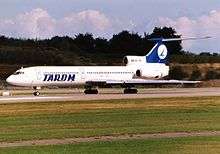
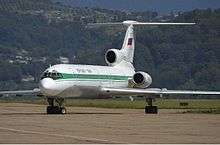


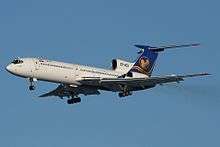
Many variants of this airliner have been built. Like its western counterpart, the 727, many of the Tu-154s in service have been hush-kitted, and some converted to freighters.
- Tu-154
- Tu-154 production started in 1970, and the first passenger flight was performed on 9 February 1972. Powered by Kuznetsov NK-8-2 turbofans, it carried 164 passengers. About 42 were built.
- Tu-154A
- The first upgraded version of the original Tu-154, the A model, in production since 1974, added center-section fuel tanks and more emergency exits, while engines were upgraded to higher-thrust Kuznetsov NK-8-2U. Other upgrades include automatic flaps/slats and stabilizer controls and modified avionics. Max. takeoff weight – 94,000 kg (207,235 lb). There were 15 different interior layouts for the different domestic and international customers, seating between 144 and 152 passengers. To discern the A model from the base model note the spike at the junction of the fin and tail. This is a fat bullet on the A model, and a slender spike on the base model.[11]
- Tu-154B
- As the original Tu-154 and Tu-154A suffered wing cracks after a few years in service, a version with a new, stronger wing, designated Tu-154B, went into production in 1975. It also had an additional fuselage fuel tank, additional emergency exits in the tail. Also, the maximum takeoff weight increased to 98,000 kg (216,053 lb). Important to Aeroflot was the increased passenger capacity, hence lower operating costs. With the NK-8-2U engines the only way to improve the economics of the airplane was to spread costs across more seats.[12] The autopilot was certified for ICAO Category II automatic approaches. Most previously built Tu-154 and Tu-154A were also modified into this variant, with the replacement of the wing. Maximum takeoff weight increased to 96,000 kg (211,644 lb). 111 were built.
- Tu-154B-1
- Aeroflot wanted this version for increased revenue on domestic routes. It carried 160 passengers. This version also had some minor modifications to the fuel system, avionics, air conditioning, and landing gear. 64 were built from 1977 to 1978.
- Tu-154B-2
- A minor modernization of Tu-154B-1. The airplane was designed to be converted from the 160 passenger version to a 180 passenger version by removing the galley.[13] The procedure took about 2 1/2 hours. Some of the earlier Tu-154Bs were modified to that standard. Maximum takeoff weight increased to 98,000 kg (216,053 lb), later to 100,000 kg (220,462 lb). Some 311 aircraft were built, including VIP versions. A few remain in service.
- Tu-154S
- The Tu-154S is an all-cargo or freighter version of the Tu-154B, using a strengthened floor, and adding a forward cargo door on the port side of the fuselage. The aircraft could carry nine Soviet PAV-3 pallets. Maximum payload – 20,000 kg (44,092 lb). There were plans for 20 aircraft, but only nine were converted, two from Tu-154 models and seven from Tu-154B models. Trials were held in the early 1980s and the aircraft was authorized regular operations in 1984. By 1997 all had been retired.[14]
- Tu-154M
- The Tu-154M and Tu-154M Lux are the most highly upgraded versions, which first flew in 1982 and entered mass production in 1984. It uses more fuel-efficient Soloviev D-30KU-154 turbofans. Together with significant aerodynamic refinement, this led to much lower fuel consumption hence longer range, as well as lower operating costs. The aircraft has new double-slotted (instead of triple-slotted) flaps, with an extra 36-degree position (in addition to existing 15, 28 and 45-degree positions on older versions), which allows reduction of noise on approach. It also has a relocated auxiliary power unit and numerous other improvements. Maximum takeoff weight increased first to 100,000 kg (220,462 lb), then to 102,000 kg (224,872 lb). Some aircraft are certified to 104,000 kg (229,281 lb). About 320 were manufactured. Mass production ended in 2006, though limited manufacturing continued as of January 2009. No new airframes have been built since the early 1990s, and production since then involved assembling aircraft from components on hand.[15] Chinese Tu-154MD electronic intelligence aircraft carry a large-size synthetic aperture radar (SAR) under their mainframe.[16]
- Tu-154M-LK-1
- Cosmonaut trainer. This was a salon VIP aircraft modified to train cosmonauts to fly the Buran reusable spacecraft, the Soviet equivalent of the US Space Shuttle. The Tu-154 was used because the Buran required a steep descent, which the Tu-154 was capable of replicating. The cabin featured trainee workstations, one of which was identical to the Buran's flightdeck. The forward baggage compartment was converted into a camera bay, as the aircraft was used to train cosmonauts in observation and photographic techniques.[17]
- Tu-154M-ON monitoring aircraft
- Germany modified one of the Tu-154s it inherited from the former East German Air Force into an observation airplane. This aircraft was involved with the Open Skies inspection flights. It was converted at the Elbe Aircraft Plant (Elbe Flugzeugwerke) in Dresden, and flew in 1996. After 24 monitoring missions, it was lost in a mid-air collision in 1997.[18]
- The Russians also converted a Tu-154M to serve as an Open Skies monitoring aircraft. They used the Tu-154M-LK-1, and converted it to a Tu-154M-ON. When not flying over North America, it is used to ferry cosmonauts. China is believed to have converted one Tu-154 to an electronic countermeasures aircraft.[19]
- Tu-154M-100
- Design of this variant started in 1994, but the first aircraft were not delivered until 1998. It is an upgraded version with Western avionics, including the Flight Management Computer, GPS, EGPWS, TCAS, and other modern systems. The airplane could carry up to 157 passengers. The cabin featured an automatic oxygen system and larger overhead bins. Three were produced, as payment of debts owed by Russia to Slovakia. Three aircraft were delivered in 1998 to Slovak Airlines, and sold back to Russia in 2003.[20]
- Tu-155
- A Tu-154 converted into a testbed for alternative fuels. It first flew in 1988 and was used until the fall of the Soviet Union, when it was placed in storage.
- Tu-164
- Initial designation of the Tu-154M.
- Tu-174
- Proposed stretched version of Tu-154.
- Tu-194
- Proposed shortened version of Tu-154.
Operators
Current operators

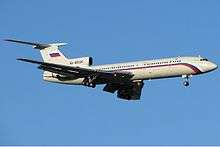
.jpg)
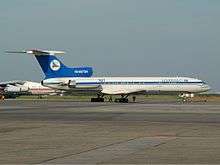

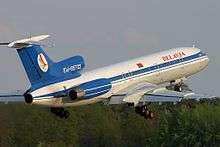
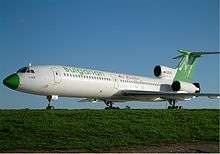
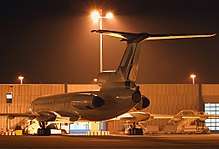
As of August 2017, there were 44[21] Tupolev Tu-154 aircraft of all variants still in civil or military service. A 45th aircraft has been sighted flying with Air Kyrgyzstan in 2017,[22] but is not listed by the airline as part of its fleet. A 46th aircraft, a Polish Tu-154 with operational number 102, is currently in storage at the military airport in Mińsk Mazowiecki. It was operated by 36th Special Aviation Regiment, but after 2010 Polish Air Force Tu-154 Crash of the Tu-154 101, the Regiment has been disbanded and the plane was grounded. It is fully operational, but government decided to do not use it or sell until the investigation into the Smoleńsk crash is finished, so, as for August 2019 the aircraft is not flying, but it is likely for it to come back into service, although most probably not for Polish government, as the government operates a fleet of brand-new, more fuel-efficient jets like the Embraer E-190 and the Boeing 737 MAX.
In January 2010 Russian flag carrier Aeroflot announced the retirement of its Tu-154 fleet after 40 years, with the last scheduled flight being Aeroflot Flight 736 from Yekaterinburg to Moscow on 31 December 2009.[23] In December 2010, Uzbekistan Airways also declared that it was retiring its Tu-154s.[24]
In February 2011, all remaining Iranian Tu-154s were grounded after two incidents.[25][26]
The remaining operators are:[27]
| Airline | In service | Notes |
|---|---|---|
| 2 | ||
| 1 | Last Russian passenger airline to operate this aircraft | |
| 1 | ||
| 2 | ||
| 1 | ||
| 12[28] | six of them are of ELINT versions with synthetic aperture radar[29] and six–eight of them are airliners | |
| 16 | ||
| 4 | Operated for the government | |
| 2 | ||
| 1 | ||
| 1 | ||
| Total: | 44 |
On 27 December 2016, the Russian Ministry of Defence announced that it had grounded all of its Tu-154s until the end of the investigation into the December 2016 crash of a 1983 Tupolev Tu-154.[30] This was followed by the grounding of all Tu-154s in Russia.[31] The Tu-154 had crashed into the Black Sea just after takeoff from Sochi, Russia, on 25 December 2016 killing all 92 people on board, including 64 members of the Alexandrov Ensemble, an official army choir of the Russian Armed Forces. The Red Army Choir singers and dancers were en route to Syria to entertain Russian troops in the run-up to the New Year.
Former operators
Former civil operators
- Air Via
- Balkan Bulgarian Airlines
- BH Air
- Bulgarian Air Charter
- Government of Bulgaria
- Hemus Air
- CAAC Airlines
- China Northwest Airlines
- China Southwest Airlines
- China United Airlines
- China Xinjiang Airlines
- Sichuan Airlines
- CSA Czech Airlines
- Government of Czech Republic
- Smartwings
- CSA Czechoslovak Airlines
- Government of Czechoslovakia
- Malev Hungarian Airlines
- Pannon Airlines
- Bon Air
- Caspian Airlines
- HESA (Operating Armita Labs that are Tu-154 converted to flying laboratories)[33]
- Iran Air Tours
- Kish Air
- Mahan Air
- Taban Air
- Air Kazakhstan
- Aeroservice Kazakhstan
- Atyrau Airways
- Kaz Air Trans
- Kazakhstan Airlines
- Sayakhat Airlines
- Libyan Arab Airlines
- Avioimpex
- Macedonian Air Service
- MAT Macedonian Airlines
- Government of Romania
- TAROM
- Abakan-Avia
- Aeroflot
- Aero Rent
- Airlines 400
- ALAK (airline)
- Aviaenergo
- Avial (airline)
- Aviaprad
- Baikal Airlines
- BAL Bashkirian Airlines
- Bural
- Chernomor Avia
- Continental Airways
- Dalavia
- Donavia
- Enkor
- Gazpromavia
- Jet-2000
- KD Avia
- Kogalymavia (Metrojet)
- KrasAir
- Kuban Airlines
- Mavial Magadan Airlines
- Nordavia
- Omskavia
- Orenair
- Perm Airlines
- Polet Airlines
- Pulkovo Aviation Enterprise
- Rossiya
- Russian Sky Airlines
- Sayany Airlines
- S7 Airlines
- Sakha Avia
- Samara Airlines
- Sibaviatrans
- Tatarstan Airlines
- Ural Airlines
- UTair Aviation
- VIM Airlines
- Vladivostok Air
- Vnukovo Airlines
- Yakutia Airlines
- Syrianair
- Active Air
- Greenair
- Holiday Airlines
Former military operators
.jpg)

- Armenian Air Force

- Bulgarian Air Force One 154B retired 1988; one 154M retired April 2010, replaced by A319 CFM

- Cuban Air Force

- Czechoslovak Air Force (passed on to successor states)

- Czech Air Force (replaced by Airbus A319CJ)

- East German Air Force (passed on to FRG)

- German Air Force (taken over from East Germany; one lost in mid-air collision, the other one sold)

- Mongolian Air Force

- Polish Air Force – 1 Tu-154M was retired in 2011, 1 Tu-154M crashed in 2010.

- Slovak Government Flying Service (replaced by Airbus A319CJ)

- Soviet Air Force (passed on to successor states)
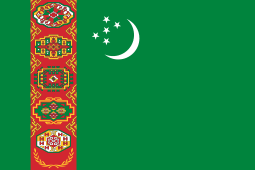
- Military of Turkmenistan – two Tu-154B-2 retired

- Ukrainian Air Force

- Military of Uzbekistan
Incidents and accidents
Between 1970 and December 2016 there have been 110 serious incidents involving the Tu-154,[34] and 69 hull losses, 30 of which did not involve fatalities.[35] Of the fatal incidents, five resulted from terrorist or military terrorist action (two other wartime losses were non-fatal), several from poor runway conditions in winter (including one in which the airplane struck snow plows on the runway), cargo overloading in the lapse of post-Soviet federal safety standards, and mid-air collisions due to faulty air traffic control. Other incidents resulted from mechanical problems (two cases prior to 2001), running out of fuel on unscheduled routes, pilot errors (including inadequate flight training for new crews), and cargo fires; several accidents remain unexplained.
The Tu-154 is described as having an average (or better than expected) safety record considering its length of service and heavy use in demanding conditions where other airliners are unable to operate.[4] On 2 January 2011, Russia's Federal Transport Oversight Agency advised airlines to stop using remaining examples of the Tu-154 (B variant) until the fatal fire incident in Surgut had been investigated.[36] Its operation in Iran ceased in February 2011 due to a number of crashes and incidents involving the type (almost 9% of all Tu-154 losses have occurred in Iran). This grounding compounded the effects of US embargo on civil aircraft parts, substantially decreasing the number of airworthy aircraft in the Iranian civil fleet.[37] In 2010 there were two fatal losses of the Tu-154 due to pilot error and/or weather conditions (a Polish presidential jet attempting a rural airfield landing in heavy fog, the 2010 Polish Air Force Tu-154 crash, and a Russian-registered plane that suffered engine stall after a crew member accidentally de-activated a fuel transfer pump). Following these accidents, in March 2011 the Russian Federal Bureau of Aviation recommended a withdrawal of remaining Tu-154Ms from service.[38]
On 27 December 2016, the Russian Defence Ministry grounded all Tu-154s in Russia pending investigation into the 25 December 2016 Tupolev Tu-154 crash which killed 64 members of the Alexandrov Ensemble, an official Red Army Choir of the Russian Armed Forces.[30][31]
List
| Date | Tail number | Aircraft type | Location | Fatalities | Description | Refs |
|---|---|---|---|---|---|---|
| 19 February 1973 | CCCP-85023 | Tu-154 | 66/100 | Aeroflot Flight 141 crashed 467 m (1,532 ft) short of the runway; the cause was not determined. | [39] | |
| 7 May 1973 | CCCP-85030 | Tu-154 | 0/6 | Force-landed during a training flight following loss of engine power and severe vibrations after the aircraft took off with the inner spoilers deployed. | [40] | |
| 10 July 1974 | SU-AXB | Tu-154 | 6/6 | Stalled and crashed during a training flight. | [41] | |
| 30 September 1975 | HA-LCI | Tu-154A | 60/60 | Malév Flight 240 crashed in the sea on final approach in clear weather, allegedly shot down by one or two air-to-air missiles fired by either IDF or SDF forces. | [42] | |
| 1 June 1976 | CCCP-85102 | Tu-154A | 46/46 | Aeroflot Flight 418 crashed into a mountain on final approach; radar failure was blamed. | [43] | |
| 1976 | CCCP-85020 | Tu-154 | 0 | Rough landing, written off. This aircraft is now in the Ukraine Government Museum of Aviation. | [44] | |
| 2 December 1977 | LZ-BTN | Tu-154A | 59/165 | Crashed due to fuel exhaustion while searching for an alternate airport after diverting due to fog. The aircraft was leased from Balkan Bulgarian Airlines. | [45] | |
| 23 March 1978 | LZ-BTB | Tu-154B | 4/4 | Crashed into high ground on final approach. | [46] | |
| 19 May 1978 | CCCP-85169 | Tu-154B | 4/134 | Aeroflot Flight 6709 crashed in a field after all three engines failed after the flight engineer accidentally shut off the automatic transferring of fuel of the sump tank. | [47] | |
| 30 June 1979 | P-551 | Tu-154B | 0 | A Choson Minhang charter flight stalled while landing due to pilot error. The right landing gear collapsed and the right wing hit the ground, sustaining damage to the wing structure. The aircraft was subsequently repaired and returned to service. | [48] | |
| 1 March 1980 | CCCP-85103 | Tu-154A | 0/161 | Landed hard and broke in two after the crew deviated from the glide path while on approach. | [49] | |
| 8 July 1980 | CCCP-85355 | Tu-154B-2 | 166/166 | Aeroflot Flight 4225 stalled and crashed on climb out after entering a downdraft. This accident remains the worst in Kazakhstan. | [50] | |
| 7 August 1980 | YR-TPH | Tu-154B-1 | 1/168 | Ditched 300 m (980 ft) short of the runway. | [51] | |
| 8 October 1980 | CCCP-85321 | Tu-154B-2 | 0/184 | Landed hard after coming in too high. | [52] photo | |
| 13 June 1981 | CCCP-85029 | Tu-154 | 0 | Overran the runway on landing and broke in two. | [53] | |
| 21 October 1981 | HA-LCF | Tu-154B | 0/81 | Malev Flight 641 crashed on the runway and broke in two after deploying the spoilers at low altitude following a too-high approach. | [54] | |
| 16 November 1981 | CCCP-85480 | Tu-154B-2 | 99/167 | Aeroflot Flight 3603 crashed 470 m short of runway due to overloading and crew error. | [55] | |
| 11 October 1984 | CCCP-85243 | Tu-154B-1 | 4+174/179 | Aeroflot Flight 3352 crashed after colliding with maintenance vehicles on the runway due to ATC error. ATC personnel received prison sentences of 12–15 years. This accident is the second deadliest in Soviet history and remains the deadliest on Russian soil. | [56] | |
| 23 December 1984 | CCCP-85338 | Tu-154B-2 | 110/111 | Aeroflot Flight 3519 crashed following double engine failure and in-flight fire. | [57] | |
| 10 July 1985 | CCCP-85311 | Tu-154B-2 | 200/200 | Aeroflot Flight 7425 stalled and crashed due to crew errors and fatigue. This accident is the deadliest in Soviet history, the deadliest in Uzbekistan, and deadliest accident involving the Tu-154. | [58] | |
| 21 May 1986 | CCCP-85327 | Tu-154B-2 | 0 | Deformation of fuselage due to crew errors during flight after the crew forgot to turn on the pitot heating system. | [59] | |
| 18 January 1988 | CCCP-85254 | Tu-154B-1 | 11/143 | Broke in three following a heavy landing. | [60] | |
| 8 March 1988 | CCCP-85413 | Tu-154B-2 | 9/84 | Aeroflot Flight 3739 was hijacked by the Ovechkin family. | [61] | |
| 24 September 1988 | CCCP-85479 | Tu-154B-2 | 0/168 | Landed hard and left the runway after encountering light turbulence on approach. | [62] | |
| 13 January 1989 | CCCP-85067 | Tu-154S | 0 | Overran runway and crashed following a rejected takeoff due to shifting cargo and overloading. | [63] | |
| 9 February 1989 | YR-TPJ | Tu-154B-2 | 5/5 | Crashed on takeoff due to engine failure during a training flight. | [64] | |
| 20 October 1990 | CCCP-85268 | Tu-154B-2 | 0/171 | Failed to takeoff and overran runway due to overloading and center of gravity problems; written off. | [65] | |
| 17 November 1990 | CCCP-85664 | Tu-154M | 0/6 | Force-landed following a fire in the cargo hold and broke apart on landing. | [66] | |
| 23 May 1991 | CCCP-85097 | Tu-154B-1 | 2+13/178 | Landed hard short of the runway, collapsing the right landing gear and broke apart after coming in too fast in rain. | [67] | |
| 14 September 1991 | CU-T1227 | Tu-154B-2 | 0/112 | Cubana Flight 464 landed too late and overran the runway due to pilot error and poor visibility. | [68] | |
| 5 June 1992 | LZ-BTD | Tu-154B | 0/130 | Landed too late and overran the runway in bad weather. | [69] | |
| June 1992 | RA-85282 | Tu-154B-1 | 0/0 | Burned out during refueling. A second Tu-154 (RA-85234) also burned out. | [70][71] | |
| 20 July 1992 | 85222 | Tu-154B | 4+24/24 | Failed to take off due to overloading and center of gravity problems, overran the runway, striking the localizer building, and ended up in a ravine. | [72] | |
| 1 August 1992 | YA-TAP | Tu-154M | 0/0 | Destroyed during a mortar attack. The aircraft had been parked at the airport for repairs following an incident three months earlier. | [73] | |
| 5 September 1992 | CCCP-85269 | Tu-154B-1 | 0/147 | Emergency landing after the left main landing gear failed to extend. | [74] | |
| 13 October 1992 | CCCP-85528 | Tu-154B-2 | 0/67 | Failed to take off and overran the runway due to overloading and center of gravity problems. | [75] | |
| 5 December 1992 | CCCP-85105 | Tu-154A | 0/154 | Veered off the runway on landing after the pilot mistook the runway edge lights for the centerline lights. | [76] | |
| 9 January 1993 | 85533 | Tu-154B-2 | 0/165 | Indian Airlines Flight 840 crashed on landing after striking some installations next to the runway; the tail and right wing later separated and the aircraft came to rest upside down. The aircraft was leased from Uzbekistan Airways due to a pilot strike at Indian Airlines. | [77] | |
| 8 February 1993 | EP-ITD | Tu-154M | 2+131/131 | Mid-air collision. | [78] | |
| Unknown | Su-24 | |||||
| 22 September 1993 | 85163 | Tu-154B | 108/132 | Shot down and crashed on the runway. The accident remains the worst in Georgia. | [79] | |
| 23 September 1993 | 85359 | Tu-154B-2 | Unknown | Written off after suffering damage from mortar or artillery fire. | [80] | |
| 25 December 1993 | RA-85296 | Tu-154B-2 | 0/172 | Nosegear collapsed after landing in bad weather. | [81] | |
| 3 January 1994 | RA-85656 | Tu-154M | 1+124/124 | Baikal Airlines Flight 130 crashed after an in-flight fire that started in the number two engine, caused by a starter failure. | [82] | |
| 6 June 1994 | B-2610 | Tu-154M | 160/160 | China Northwest Airlines Flight 2303 broke apart in mid-air and crashed shortly after takeoff due to a maintenance error. The crash remains the worst in China. | [83] | |
| 21 January 1995 | UN-85455 | Tu-154B-2 | 0/117 | Failed to take off and overran the runway due to overloading. | [84] | |
| 7 December 1995 | RA-85164 | Tu-154B | 98/98 | Khabarovsk United Air Group Flight 3949 crashed into a mountain following a loss of control after fuel was selected from the left wing tanks to counter a left wing-low attitude. | [85] | |
| 29 August 1996 | RA-85621 | Tu-154M | 141/141 | Vnukovo Airlines Flight 2801 crashed into a mountain on final approach due to navigation errors. This accident remains the worst in Norway. | [86] | |
| 13 September 1997 | 11+02 | Tu-154M | 33/33 | German Air Force Flight 074 collided in mid-air with a USAF C-141 due to pilot and ATC errors. | [87][88] | |
| 65-9405 | C-141 | |||||
| 15 December 1997 | EY-85281 | Tu-154B-1 | 85/86 | Tajikistan Airlines Flight 3183 crashed in the desert due to pilot error and crew fatigue. | [89] | |
| 29 August 1998 | CU-T1264 | Tu-154M | 10+70/91 | Cubana de Aviación Flight 389 failed to take off and overran the runway, crashing into a soccer field. Following problems before takeoff, the crew had forgotten to select the switches for the hydraulic valves of the control system. | [90] | |
| 24 February 1999 | B-2622 | Tu-154M | 61/61 | China Southwest Airlines Flight 4509 lost control and crashed after incorrect nuts in the elevator control system fell off, due to improper maintenance. China removed the Tu-154 from service following this accident. | [91] | |
| 4 July 2000 | HA-LCR | Tu-154B-2 | 0/76 | Malév Flight 262 touched down wheels-up while landing and skidded on runway, but was able to take off and land normally after a go-around. | [92] | |
| 4 July 2001 | RA-85845 | Tu-154M | 145/145 | Vladivostok Air Flight 352 stalled and crashed on final approach due to pilot error. | [93] | |
| 4 October 2001 | RA-85693 | Tu-154M | Black Sea off Sochi | 78/78 | Siberia Airlines Flight 1812 was accidentally shot down by an errant Ukrainian S-200 surface-to-air missile. | [94] |
| 12 February 2002 | EP-MBS | Tu-154M | 119/119 | Iran Air Tours Flight 956 struck a mountain on approach. | [95] | |
| 20 February 2002 | EP-LBX | Tu-154M | 0 | Landed hard, suffering substantial damage. The aircraft was ferried to Vnukovo for repairs where the nose gear collapsed while the aircraft was being towed. The aircraft was written off and used for spare parts. | [96] | |
| 1 July 2002 | RA-85816 | Tu-154M | 2+69/69 | Bashkirian Airlines Flight 2937 collided in mid-air with DHL Flight 611 due to errors of communication between instruction from ATC and Traffic collision avoidance system. | [97][98] | |
| A9C-DHL | 757-200 | |||||
| 24 August 2004 | RA-85556 | Tu-154B-2 | 46/46 | Sibir Airlines Flight 1047 crashed after it was bombed in mid-air by a suicide bomber, along with a Tu-134 on the same day. | [99] | |
| 22 August 2006 | RA-85185 | Tu-154M | 170/170 | Pulkovo Airlines Flight 612 stalled and crashed after the crew attempted to fly over a storm front. The aircraft entered turbulence and later stalled. The aircraft entered a flat spin and then struck the ground. | [100] | |
| 1 September 2006 | EP-MCF | Tu-154M | 28/148 | Iran Air Tours Flight 945 suffered a mishap while landing, possibly due to a blown nosegear tire. The aircraft swerved off the runway. | [101] | |
| 30 June 2008 | RA-85667 | Tu-154M | 0/112 | Aeroflot Flight 846 had its number one engine suffer an uncontained failure during takeoff and takeoff was aborted. The aircraft was parked at Pulkovo Airport after the incident and was broken up in August 2009. | [102] | |
| 15 July 2009 | EP-CPG | Tu-154M | 168/168 | Caspian Airlines Flight 7908 lost control and crashed following an engine fire. | [103] | |
| 24 January 2010 | RA-85787 | Tu-154M | 0/170 | Taban Air Flight 6437 crashed on landing after the captain declared a medical emergency due to a seriously ill passenger on board. The aircraft was leased from Kolavia. | [104] | |
| 10 April 2010 | 101 | Tu-154M | 96/96 | Crashed on final approach in thick fog on an airfield without ILS. Polish President Lech Kaczyński and other high-ranking officials were on board and died in the crash. | [105] | |
| 7 September 2010 | RA-85684 | Tu-154M | 0/81 | Alrosa Flight 514 made an emergency landing at a remote disused airfield after a total electrical failure in cruise, overran the runway and was damaged, but no-one was injured. In 2011, the aircraft was repaired, flown out and returned to service. | [106][107] | |
| 4 December 2010 | RA-85744 | Tu-154M | 2/170 | Dagestan Airlines Flight 372 made an emergency landing after two engines failed shortly after takeoff; full of fuel. Overran the runway and broke up into three. The accident investigation revealed that a crew member had mistakenly switched off a fuel transfer pump thereby causing fuel-starvation and subsequent engine flameout. | [108] | |
| 1 January 2011 | RA-85588 | Tu-154B-2 | 3/124 | Kolavia Flight 348 caught fire while taxiing for takeoff. | [109] | |
| 25 December 2016 | RA-85572 | Tu-154B-2 | 92/92 | Russian Defence Ministry flight crashed en route to Khmeimim, Syria, killing all 92 people (84 passengers and 8 crew members) on board, including 64 members of the Alexandrov Ensemble, an official army choir of the Russian Armed Forces | [110][111] |
Aircraft on display
_(5869577851).jpg)
.jpg)
- CCCP-85020 a Tu-154 at the Ukraine State Aviation Museum.[112]
- EW-85581 a Tu-154B-2 in the grounds of Minsk National Airport in Belarus.
- HA-LCG a Tu-154B-2 at the Aeropark museum in Budapest.[113]
- LZ-BTU a Tu-154B-2 at the Aviomuseum Burgas museum in Burgas, Bulgaria.[114]
Specifications
| Measurement | Tu-154B-2 | Tu-154M |
|---|---|---|
| Cockpit crew | 5(Tu-154B)-3(Tu-154M)[115] | |
| Seating capacity | 114–180 | |
| Length | 48.0 metres (157 ft 6 in) | |
| Wingspan | 37.55 metres (123 ft 2 in) | |
| Wing area | 201.5 square metres (2,169 sq ft) | |
| Height | 11.4 metres (37 ft 5 in) | |
| Cabin width | 3.58 metres (11 ft 9 in)[116] | |
| Maximum take-off weight | 98,000 kilograms (216,000 lb) – 100,000 kilograms (220,000 lb) | 102,000 kilograms (225,000 lb) – 104,000 kilograms (229,000 lb) |
| Empty weight | 50,700 kilograms (111,800 lb) | 55,300 kilograms (121,900 lb) |
| Maximum speed | 913 km/h (M 0,86)[117] | |
| Range fully loaded | 2,500 km (1,300 nmi; 1,600 mi) | 5,280 km (2,850 nmi; 3,280 mi) |
| Range with max fuel | 3,900 km (2,100 nmi; 2,400 mi) | 6,600 km (3,600 nmi; 4,100 mi) |
| Service ceiling | 12,100 metres (39,700 ft) | |
| Engine (x 3) | Kuznetsov NK-8-2U | Soloviev D-30KU-154 |
| Max. thrust (x 3) | 90 kN (20,000 lbf) each[118] | 103 kN (23,148 lbf) each[118] |
| Max. fuel capacity | 47,000 litres (10,000 imp gal; 12,000 US gal) | 49,700 litres (10,900 imp gal; 13,100 US gal) |
In popular culture
- Tu-154 is the most popular airliner appearing in many Soviet and Russian films.
- Air Crew is the 1979 action film revolving around the exploits of a Soviet Tu-154 crew on an international flight, the first Soviet film in the disaster genre.
See also
Related development
Aircraft of comparable role, configuration and era
Related lists
References
Citations
- Rabinowitz, Jason (26 February 2013). "Last Tupolev TU-154 Delivered – 16 Years After Production Ceases". Airline Reporter. Archived from the original on 12 December 2013. Retrieved 12 December 2013.
- "Tu-154 – Туполев". www.tupolev.ru. Archived from the original on 20 December 2016. Retrieved 11 January 2017.
- "Crash focuses attention on Tupolev-154". BBC News. 10 April 2010. Archived from the original on 13 April 2010. Retrieved 26 May 2010.
- Tu-154: The backbone of Russian fleets Archived 1 June 2009 at the Wayback Machine BBC News
- Komissarov, p. 8
- Komissarov, pp. 5, 18
- "News Channel | Homepage". Flightglobal.com. Archived from the original on 21 May 2011. Retrieved 22 October 2019.
- "AeroTransport Data Bank". Archived from the original on 21 November 2002. Retrieved 26 December 2014.
- "The Last Serial Tu-154 Was Delivered to the Representatives of Russian Defense Ministry". Vzglyad.Ru. 19 February 2013. Archived from the original on 22 February 2013. Retrieved 19 February 2013.
- "Наука и техника: Оружие: Шойгу получит последний самолет Ту-154М". Lenta.ru. Archived from the original on 15 May 2013. Retrieved 16 August 2013.
- Komissarov, p. 21
- OKB Tupolev, A History of the Design Bureau and its Aircraft, Yefin Gordon and Vladimir Rigmant, translated by Alexander Boyd, edited by Dmitriy Komissarov (Hinckley, UK, 2005) ISBN 1-85780-214-4 p. 257.
- Komissarov, p. 27
- Komissarov, pp. 29–31
- Komissarov, p. 34
- "AirForceWorld.com Tu154md Electronic Intelligence Aircraft". AirForceWorld.com. Archived from the original on 5 March 2011. Retrieved 30 April 2011.
- Komissarov, pp. 36–37
- Komissarov, pp. 38–39
- Komissarov, p. 40
- Komissarov, pp. 36, 144–145
- "✈ russianplanes.net ✈ наша авиация". russianplanes.net. Archived from the original on 13 March 2013. Retrieved 26 December 2016.
- "✈ russianplanes.net ✈ наша авиация". russianplanes.net. Archived from the original on 15 August 2017. Retrieved 15 August 2017.
- "Aeroflot retires the legendary TU-154s". Flight Global. 18 January 2010. Archived from the original on 27 January 2010. Retrieved 17 December 2010.
- "Uzbekistan Airways renews aircraft fleet". Archived from the original on 17 July 2011.
- "Iranian airlines fleet". Archived from the original on 6 September 2010.
- Kramer, Andrew E. (21 June 2011). "It Danced Once, but More Often It Crashes". New York Times. Archived from the original on 26 December 2016. Retrieved 20 February 2017.
- ch-aviation.com – Aircraft Quick Search: Tu-154 Archived 11 June 2015 at the Wayback Machine retrieved 10 June 2015
- "✈ russianplanes.net ✈ наша авиация". russianplanes.net. Archived from the original on 11 December 2016. Retrieved 26 December 2016.
- "Prior To Landing Troops in India, China Carried Out Spy Sorties With Tupolev Tu154M Aircraft". www.defenseworld.net. Archived from the original on 15 November 2017. Retrieved 14 November 2017.
- "Russia grounds all its TU-154 planes after crash". RTE.ie. 27 December 2016. Archived from the original on 28 December 2016. Retrieved 27 December 2016.
- "PressTV-Russia grounds all Tupolev-154s after jet crash". presstv.ir. Archived from the original on 28 December 2016. Retrieved 27 December 2016.
- BH Airlines Archived 17 October 2015 at the Wayback Machine at rzjets.net, Retrieved 13 December 2014
- "Iran unveils upgraded missile, five pieces of military hardware". Tehran Times. Archived from the original on 25 August 2012. Retrieved 16 August 2013.
- Harro Ranter. "Aviation Safety Network – ASN Aviation Safety Database results". Archived from the original on 4 March 2016. Retrieved 26 December 2016.
- Harro Ranter. "Aviation Safety Network – ASN Aviation Safety Database results". Archived from the original on 24 April 2015. Retrieved 26 December 2014.
- "Russian airlines should ground Tu-154s, watchdog says". BBC News. 2 January 2011. Archived from the original on 3 January 2011. Retrieved 2 January 2011.
- "از اول اسفند ارابههاي مرگ در آسمانها زمينگير ميشود".
- "Rosja. Tu-154M mogą wyjść z eksploatacji od 1 lipca". Rzeczpospolita. Archived from the original on 2 April 2015. Retrieved 26 December 2014.
- Accident description for CCCP-85023 at the Aviation Safety Network
- Accident description for CCCP-85030 at the Aviation Safety Network
- Accident description for SU-AXB at the Aviation Safety Network
- Accident description for HA-LCI at the Aviation Safety Network
- Accident description for CCCP-85102 at the Aviation Safety Network
- Accident description for CCCP-85020 at the Aviation Safety Network
- Accident description for LZ-BTN at the Aviation Safety Network
- Accident description for LZ-BTB at the Aviation Safety Network
- Accident description for CCCP-85169 at the Aviation Safety Network
- Accident description for P-885 at the Aviation Safety Network
- Accident description for CCCP-85103 at the Aviation Safety Network
- Accident description for CCCP-85355 at the Aviation Safety Network
- Accident description for YR-TPH at the Aviation Safety Network
- Accident description for CCCP-85321 at the Aviation Safety Network
- Accident description for CCCP-85029 at the Aviation Safety Network
- Accident description for HA-LCF at the Aviation Safety Network
- Accident description for CCCP-85480 at the Aviation Safety Network
- Accident description for CCCP-85243 at the Aviation Safety Network
- Accident description for CCCP-85338 at the Aviation Safety Network
- Accident description for CCCP-85311 at the Aviation Safety Network
- Accident description for CCCP-85327 at the Aviation Safety Network
- Accident description for CCCP-85254 at the Aviation Safety Network
- Accident description for CCCP-85413 at the Aviation Safety Network
- Accident description for CCCP-85479 at the Aviation Safety Network
- Accident description for CCCP-85067 at the Aviation Safety Network
- Accident description for YR-TPJ at the Aviation Safety Network
- Accident description for CCCP-85268 at the Aviation Safety Network
- Accident description for CCCP-85664 at the Aviation Safety Network
- Accident description for CCCP-85097 at the Aviation Safety Network
- Accident description for CU-T1227 at the Aviation Safety Network
- Accident description for CCCP-LZ-BTD at the Aviation Safety Network
- Accident description for RA-85282 at the Aviation Safety Network
- Accident description for RA-85234 at the Aviation Safety Network
- Accident description for 85222 at the Aviation Safety Network
- Accident description for YA-TAP at the Aviation Safety Network
- Accident description for CCCP-85269 at the Aviation Safety Network
- Accident description for CCCP-85528 at the Aviation Safety Network
- Accident description for CCCP-85105 at the Aviation Safety Network
- Accident description for 85533 at the Aviation Safety Network
- Accident description for EP-ITD at the Aviation Safety Network
- Criminal description for 85163 at the Aviation Safety Network
- Criminal description for 85359 at the Aviation Safety Network
- Accident description for RA-85296 at the Aviation Safety Network
- Accident description for RA-85656 at the Aviation Safety Network
- Accident description for B-2610 at the Aviation Safety Network
- Accident description for UN-85455 at the Aviation Safety Network
- Accident description for RA-85164 at the Aviation Safety Network
- Accident description for RA-85621 at the Aviation Safety Network
- Accident description for 11+02 at the Aviation Safety Network
- Accident description for 65-9405 at the Aviation Safety Network
- Accident description for EY-85281 at the Aviation Safety Network
- Accident description for CU-T1264 at the Aviation Safety Network
- Accident description for B-2622 at the Aviation Safety Network
- Accident description for HA-LCR at the Aviation Safety Network
- Accident description for RA-85845 at the Aviation Safety Network
- Wines, Michael (14 October 2001). "After 9 Days, Ukraine Says Its Missile Hit A Russian Jet". The New York Times. Archived from the original on 12 March 2017. Retrieved 20 February 2017.
- Accident description for EP-MBS at the Aviation Safety Network
- Accident description for EP-LBX at the Aviation Safety Network
- Accident description for RA-85816 at the Aviation Safety Network
- Accident description for A9C-DHL at the Aviation Safety Network
- Criminal description for RA-85556 at the Aviation Safety Network
- Accident description for RA-85185 at the Aviation Safety Network
- Accident description for EP-MCF at the Aviation Safety Network
- Accident description for RA-85667 at the Aviation Safety Network
- Accident description for EP-CPG at the Aviation Safety Network
- Accident description for RA-85787 at the Aviation Safety Network
- Accident description for 101 at the Aviation Safety Network
- Alrosa Tu-154 overruns after emergency landing in Russia Archived 11 September 2010 at the Wayback Machine, FlightGlobal, 7 September 2010
- Tu-154 back in the air six months after miracle landing in taiga Archived 23 November 2012 at the Wayback Machine, RT (TV network), 24 March 2011
- BBC News – Two dead as engine failure airliner lands in Moscow Archived 30 May 2017 at the Wayback Machine. Bbc.co.uk (4 December 2010). Retrieved on 10 December 2010.
- Russian Passenger Jet Explodes; 3 Dead. Cbsnews.com (1 January 2011).
- "PressTV-92 presumed dead in Russia military plane crash". Archived from the original on 25 December 2016. Retrieved 25 December 2016.
- "Crashed near Sochi on Tu-154 was built in 1983". LatestNewsResource. 25 December 2016. Archived from the original on 26 December 2016.
- "Tu-154". Oleg Antonov State Aviation Museum. Retrieved 8 May 2020.
- "TU-154B-2". Aeropark Budapest (in Hungarian). Retrieved 8 May 2020.
- "Tupolev, Tu-154". Aviomuseum Burgas (in Bulgarian). Retrieved 8 May 2020.
- "Tu-154 – Туполев". www.tupolev.ru. Archived from the original on 9 December 2018. Retrieved 26 January 2019.
- "Tu-154 Careless". www.globalsecurity.org. Archived from the original on 15 January 2019. Retrieved 14 January 2019.
- "Tu-154B Flight Crew Operations Manual". Archived from the original on 22 September 2018. Retrieved 21 September 2018.
- Originally measured as 10,500 kgf.
Bibliography
- Dmitriy Komissarov, Tupolev Tu-154, The USSR's Medium-Range Jet Airliner, (Hinckley, UK, 2007) ISBN 1857802411
- Yefin Gordon and Vladimir Rigmant, OKB Tupolev, A History of the Design Bureau and its Aircraft, translated by Alexander Boyd, edited by Dmitriy Komissarov (Hinckley, UK, 2005) ISBN 1-85780-214-4
External links
| Wikimedia Commons has media related to Tupolev Tu-154. |